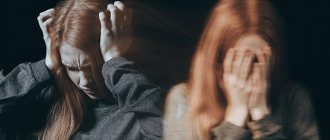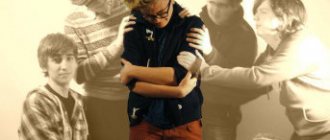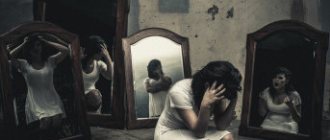Posted by Enola Gay
18 April 2021 19:46
Tags: psychiatry fears phobias
2107
11
A phobia is a symptom, the essence of which is irrational fear and excessive anxiety in anticipation of a certain event. A phobia is an obsessive fear that irreversibly worsens in certain situations and cannot be explained logically.
0
See all photos in the gallery
Anatidaephobia is the fear of being watched by a duck.
0
A person suffering from this phobia constantly feels that somewhere in the world there is a duck (or goose) that is watching him/her (not attacking, not touching, but simply watching the person). The word Anatidaephobia comes from the Greek word 'Anatidae', which means ducks, geese and other waterfowl, and 'phobos', which means threat/fear in Greek.
×
Causes of Anatidaephobia
Anatidaephobia, or the fear of a watching duck, can arise from a negative or even traumatic incident involving ducks or geese.
Such birds are known to often behave aggressively and fly at people without any provocation from humans. They often pinch a person to steal food or water from their hands. Most people develop this phobia in childhood. A child may directly or indirectly experience aggression from ducks or geese:
- He may have acquired this fear after hearing and being afraid of the threatening sound made by the large wings of birds as they flap and fap.
- Or, the child got scared when a duck or goose, hissing threateningly, ran at him with the aim of attacking (trying to pinch).
These examples of bird behavior make the child feel vulnerable and afraid of the ducks or geese (in any number) around him.
In most cases, childhood phobias get rid of over time. However, in some cases, the phobia persists into adulthood.
Eisoptrophobia (spectrophobia) – fear of seeing one’s own reflection
0
The most pronounced symptoms of spectrophobia: Fear of seeing one’s image in a mirror, or, in more severe stages, in any reflective surface. Fear of being photographed and looking at your own photographs. Tension and depression in a situation when a reflective surface appears before the eyes, be it a cutlery or a glass reflection in a vehicle.
Symptoms
At the thought that somewhere nearby there was a goose hiding watching him, and even worse if he met it on his way. For example, if you come to a rural area, this is simply inevitable. Then the phobe begins to have a panic attack.
He is suffocating, it seems to him that there is not enough air, and he is simply going to die from asphyxia. The fact is that when excited, a person’s breathing becomes shallow and frequent, and this leads to hyperventilation of the lungs.
The amount of oxygen in the blood goes off scale, which causes a completely opposite effect - suffocation.
In this case, you need to breathe into your palms, a paper bag, if you have it with you. Carbon dioxide will help normalize the condition. Thanks to this, dizziness and nausea will also go away.
Also, often when panicking, there is pain in the chest and stomach. The person sweats profusely, his arms and legs are shaking, and even his chin and voice are shaking. The gait is uncertain, shaky.
Diarrhea, vomiting and loss of consciousness are sometimes observed. A person is unable not only to control his feelings, but also his thoughts and behavior.
Therefore, most often he tries to find a safe haven where he can relax and calm down.
In the meantime, he searches, desperately calls for help, cries and doesn’t really understand how to really take care of his own health and safety.
For example, in a panic, he cannot distinguish the road and risks getting hit by a car, rolling down the stairs, or even worse - jumping out of the window.
Pediophobia - fear of dolls
0
Pediophobia refers to a completely incomprehensible fear of a wide variety of dolls. It is noteworthy that in this case, a person suffering from this phobia fears not only contacts, but even the appearance of a doll of a certain type or size - this panic fear applies to all dolls, be it the luxuriously beautiful Barbie or a tiny rubber doll.
Diagnosis and treatment of Anatidaephobia
In most cases, people suffering from Anatidaephobia are aware of their fear of ducks, and even understand very well that this fear is unnatural and frivolous.
However, they are unable to control this fear. Many people refuse to see a doctor, and as a result, their phobia can persist for many years. It is important to consult your doctor/family doctor, especially if the above-mentioned phobia symptoms interfere with your daily life. Your doctor may recommend a professional therapist for follow-up, or one of the following treatments, which are known to be very effective in overcoming and eliminating your fear of ducks (geese) for good:
- Neuro-Linguistic Programming (NLP)
This therapy is based on the principle that most phobias are “learned or programmed behaviors” of the brain. NLP seeks to reprogram the mind to completely eliminate fear once and for all. - Hypnotherapy
This is another proven and safe therapy that goes deep into the mind of an anatidaephobe to reveal the root cause of their phobia. - Other self-therapy techniques
Therapists also recommend that people with phobias practice techniques to calm the mind and body such as meditation, deep breathing, writing down their positive thoughts/ideas to rationalize the negative ones associated with the fear of ducks.
Signs of fear
The presence of a phobia can be determined by the following symptoms:
- a person experiences lethargy upon seeing a bird;
- increased sweating when watching birds;
- the appearance of trembling just from the thought of a duck;
- thirst, dry mouth;
- lack of air;
- tingling in the chest area;
- discomfort in the stomach and intestines;
- nausea, vomiting.
Symptoms of a panic attack
Who might have this “funny” phobia?
Most often, this phobia “fear of ducks” can occur in children of preschool, early or middle school age, up to the age of 14, as a result of the fear experienced after meeting a waterfowl in nature.
It should be noted that girls are more susceptible to this syndrome. Statistics say that they account for 70 percent of all known cases of anatidaephobia.
There are frequent manifestations of anatidaephobia in people of adult, working age, as a result of a reaction from direct contact with waterfowl or as a relapse of an already existing mental/psychological disorder of any type.
Causes and manifestations of anatidaephobia
The most common cause is psychological trauma experienced in childhood. If a child has encountered aggressive behavior of birds (a goose has pinched him or tried to do so), the brain associates birds with danger, trouble, and negative emotions. People who encounter waterfowl in the wild can also be afraid. Children are often frightened by the loud cries of anseriformes.
Less commonly, pathology develops due to a previously existing mental disorder. May intensify if negative emotions from contact are repeated.
The manifestations are similar to those of other phobias, and there are also specific symptoms. A person experiences signs of anxiety and constantly thinks that he is under the surveillance of ducks.
Delusions of persecution arise. At first, people begin to avoid walking near bodies of water or in rural areas, where waterfowl can often be seen. Then they may stop leaving the house completely, fearing surveillance. Social adaptation is disrupted and the quality of life deteriorates.
The patient may lose his job and break off contacts with loved ones if meeting them in a “safe” area is impossible.
At the same time, most patients understand that there is a problem and want to get rid of it; the person can turn to a psychologist or psychiatrist.
At the sight of a duck or goose, a panic attack occurs. Stupor is observed. A person ceases to control his actions, may become hysterical, try to run away, hide. It is difficult for the patient to listen to other people talking about the safety of the situation; fear does not allow him to perceive what is said.
The heartbeat becomes rapid. Blood pressure increases. Pallor occurs in the face and upper chest. Sweating increases. Dryness occurs in the mouth. Trembling of the hands is typical; legs may tremble less frequently. You may feel hot or chilly. Breathing becomes confused, becomes shallow, rapid, and shallow. There may be a feeling of chest compression. Possible nausea and dizziness. Vomiting is occasionally observed.
In severe cases, the patient may lose consciousness.
Treatment
The fear of a duck that is watching you, although it seems insignificant at first glance, requires qualified treatment.
Contact a psychotherapist to work through your childhood traumas, to realize that this is exactly what happened in your life, that you are now suffering from insomnia and nightmares involving a closely watching goose.
The psychiatrist will prescribe medications that will make it possible not only to remove the symptoms of anatidaephobia, but also to relieve anxiety and normalize mood.
Sedatives and antidepressants help relax the nervous system. This means that you will again find peace, quality sleep and the opportunity to experience a whole range of feelings, not just fear and horror.
But also, let’s say, tenderness, joy, pleasure, peace and happiness.
Gestalt therapy, cognitive behavioral therapy, hypnosis and neurolinguistic programming are considered to be the most effective in the fight against phobic disorders.
Agyrophobia - fear of crossing the road
People with agyrophobia are terrified of crossing roads and highways. People with this phobia are terrified of crossing roads and highways; it happens that they also experience fear directly in front of the roadway. There are varieties of agyrophobia in which patients try to avoid wide roads or one-way streets or are afraid to cross the street in the wrong place. A close connection has been established between this disease and the fear of cars.
Causes of panophobia
In fact, the causes of the phobia have not been fully studied, and the occurrence of panophobia cannot be traced - panophobes cannot remember how their disorder began. It is reliably known that there is no genetic predisposition or congenital form of panphobia. The disorder is formed from the combination of several phobias: more and more new ones are added to an already existing complex.
Typical causes of panophobia:
- constant pressure;
- staying in a stressful situation for a long period;
- parental attention deficit;
- stress from being in a new, unusual environment;
- lack of friends;
- inability to establish relationships with other people;
- rejection of the patient by loved ones;
- negative impact of the environment;
- the prevalence of stressful situations in life (death of a loved one, divorce, serious illness of a loved one);
- a feeling of hopelessness of one’s own situation, etc.
If the disease is neglected, a more severe type of panophobia may develop – phobophobia. A person is already so exhausted that he begins to fear everything in the world, even himself, his own reflection in the mirror.
Symptoms
The symptoms of a fear of ducks are similar to those of any other phobia. The most common are:
- fainting;
- cardiopalmus;
- severe nausea during an attack;
- panic attack;
- anxiety, inability to sleep for a long time;
- apathetic state.
A visit to a park or recreation area where there is a river can turn into a tragedy for an anatidaephobe. Open area, the presence of many birds, wild ducks and swans often swim on the river. Here a person may encounter a problem related to fear.
If, while walking around the city, it just seems to him that a duck is watching him, then everything here is even very real: the bird poses a real threat to human life.
A panic attack followed by a heart attack may occur. And visiting those who have a household is also contraindicated.
A person with a fear of ducks may behave strangely in public. The strangeness lies in the constant anxious looking back and around, in search of the very duck that, according to the patient, is watching him. During an exacerbation period, such people especially feel the presence of a bird near them. This can happen from the influence of the lunar phase or weather changes, when atmospheric pressure affects the general well-being of people.
The patient should avoid households with ducks
Origin of the phobia
The reason for the fear of geese and ducks may be an unsuccessful contact with a bird, which ultimately caused a negative reaction and emotions in a person. For example, a bird bit a person or screamed loudly, which led to fright. A person who has such fear begins to withdraw into himself. He is afraid to relax on a pond where there may be birds, because a repeated meeting could aggravate the person’s serious condition.
Fear controls the lives of closed-in people. Many people know that there is a problem and realize that such fear is not serious, but they cannot get rid of it.
Such panic will not go away on its own; feelings of persecution will be constantly present.
Fighting methods
There are many ways to combat obsessive thoughts about ducks.
- Medicinal method. Seek help from your doctor. Prescribed medications and psychotherapy sessions will help you calm down and return to a normal lifestyle.
- Drink soothing tea with a decoction of chamomile, lemon balm, and mint.
- Take a course of therapeutic baths and massages. Relaxing the muscles through massage is a great way to relieve stress. A bath with herbal infusion and sea salt will relax you and help get rid of insomnia.
- Play sports. It not only strengthens muscles, but also improves the general condition of the body, stimulating the brain to work.
Try to get rid of the phobia by getting closer to the problem. The essence of the method is to show yourself that these animals are not scary. Try looking at the little, newly hatched ducklings - they are so cute.
It is not necessary to immediately encounter this in person, just watch videos or pictures about them, then you can try to pet a live duckling. Small birds are completely harmless. Some people even tame ducks, teach them funny dances, and make separate houses for them.
Treatment of the disorder
Based on the observed symptoms, treatment for fear is prescribed by a psychotherapist or psychiatrist. The phobia is rarely cured completely; cure most often occurs if therapy was started in childhood or adolescence.
Hypnosis is often used. Using this technique, psychiatrists can easily determine the cause of the pathology. In addition, hypnotic influence allows you to reprogram your consciousness and create an attitude about the safety of ducks and geese.
It is possible to use neurolinguistic programming (NLP).
If persecutory delusions are noted, the psychiatrist selects medications. Sedatives are used. In mild forms of the disease, a person may be advised to take mild sedatives before imminent contact with birds that frighten him. All medications and individual dosages must be selected by a doctor.
You should not self-medicate: incorrectly selected methods of therapy will only lead to the condition worsening.











